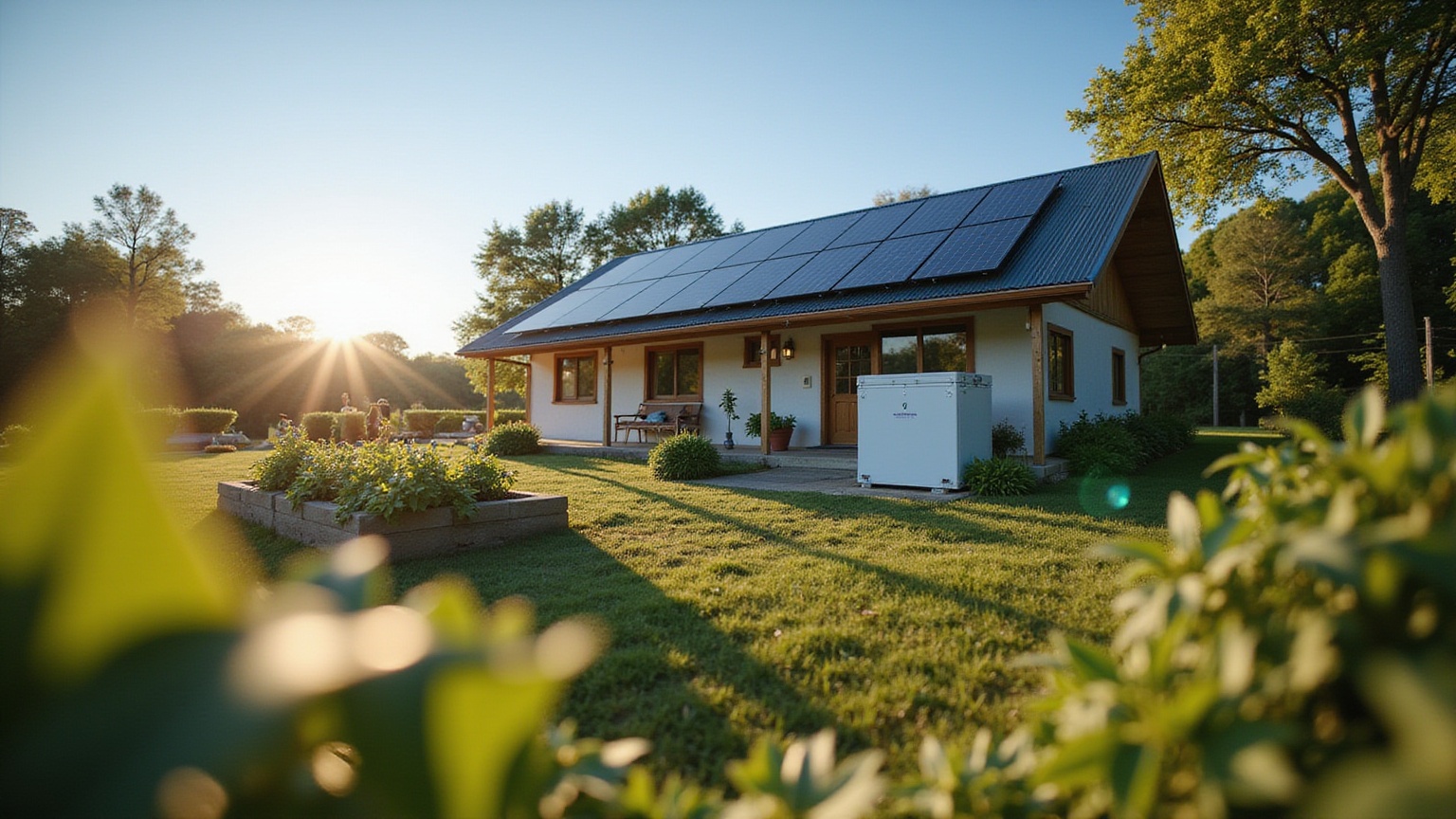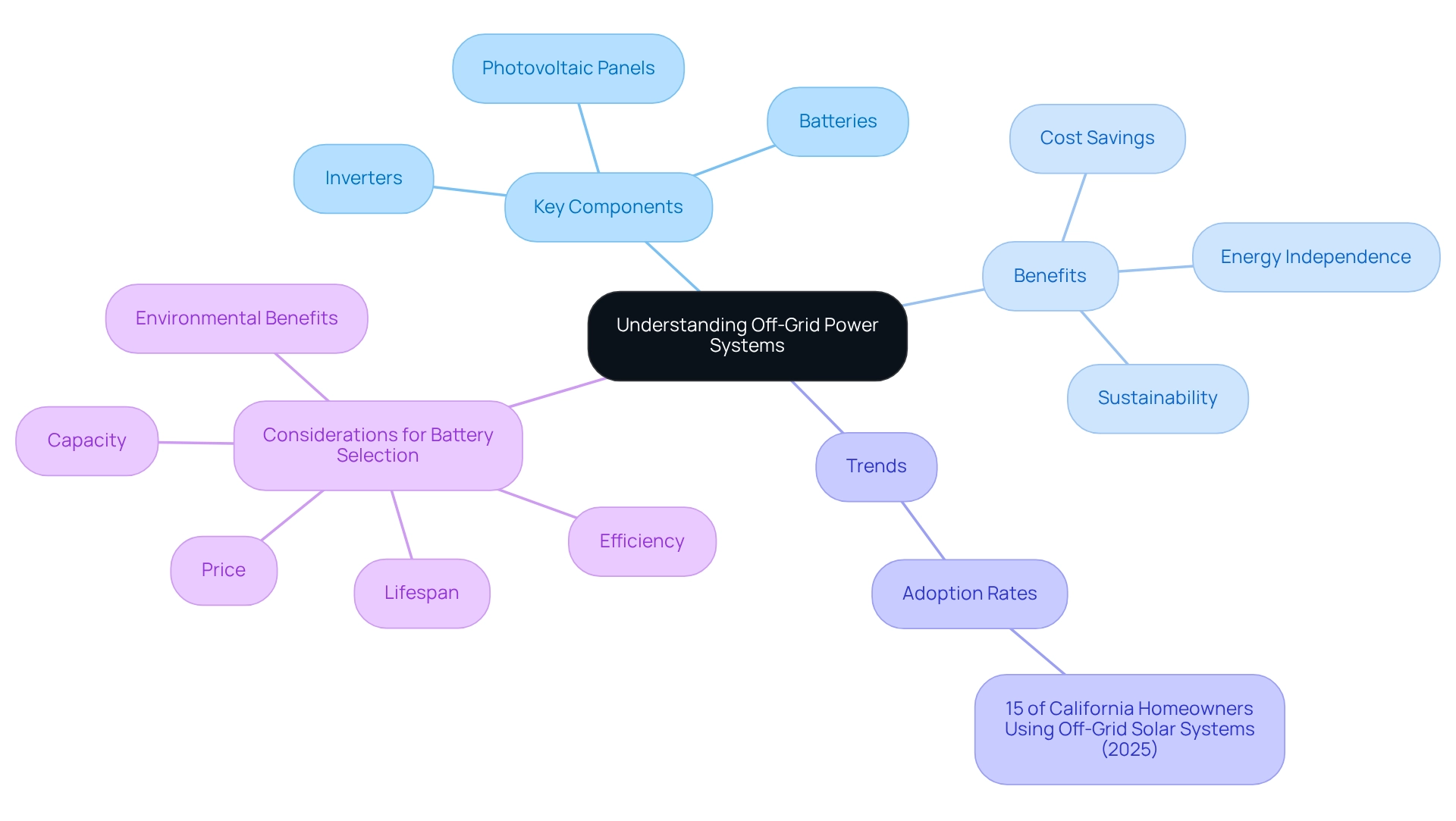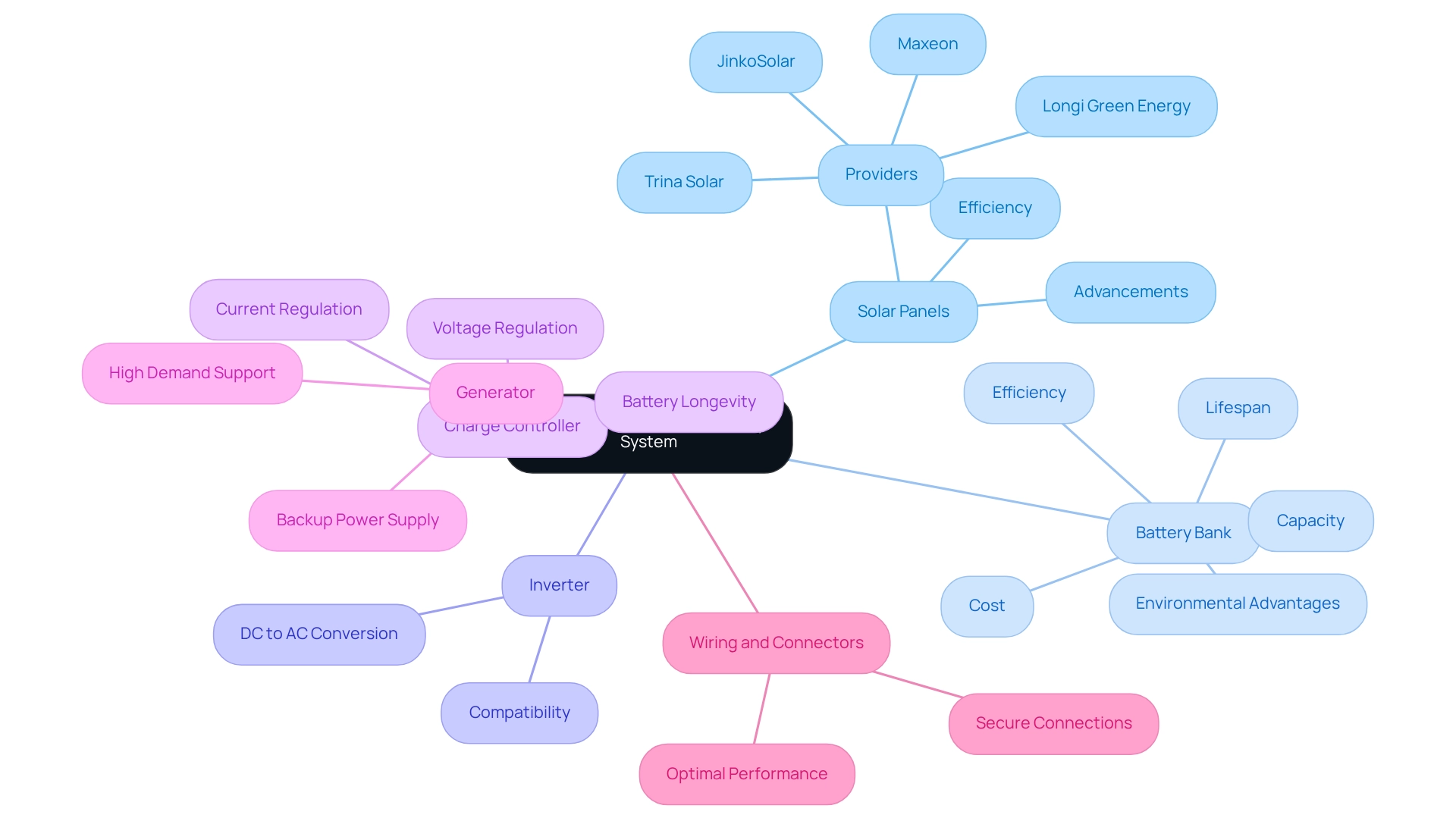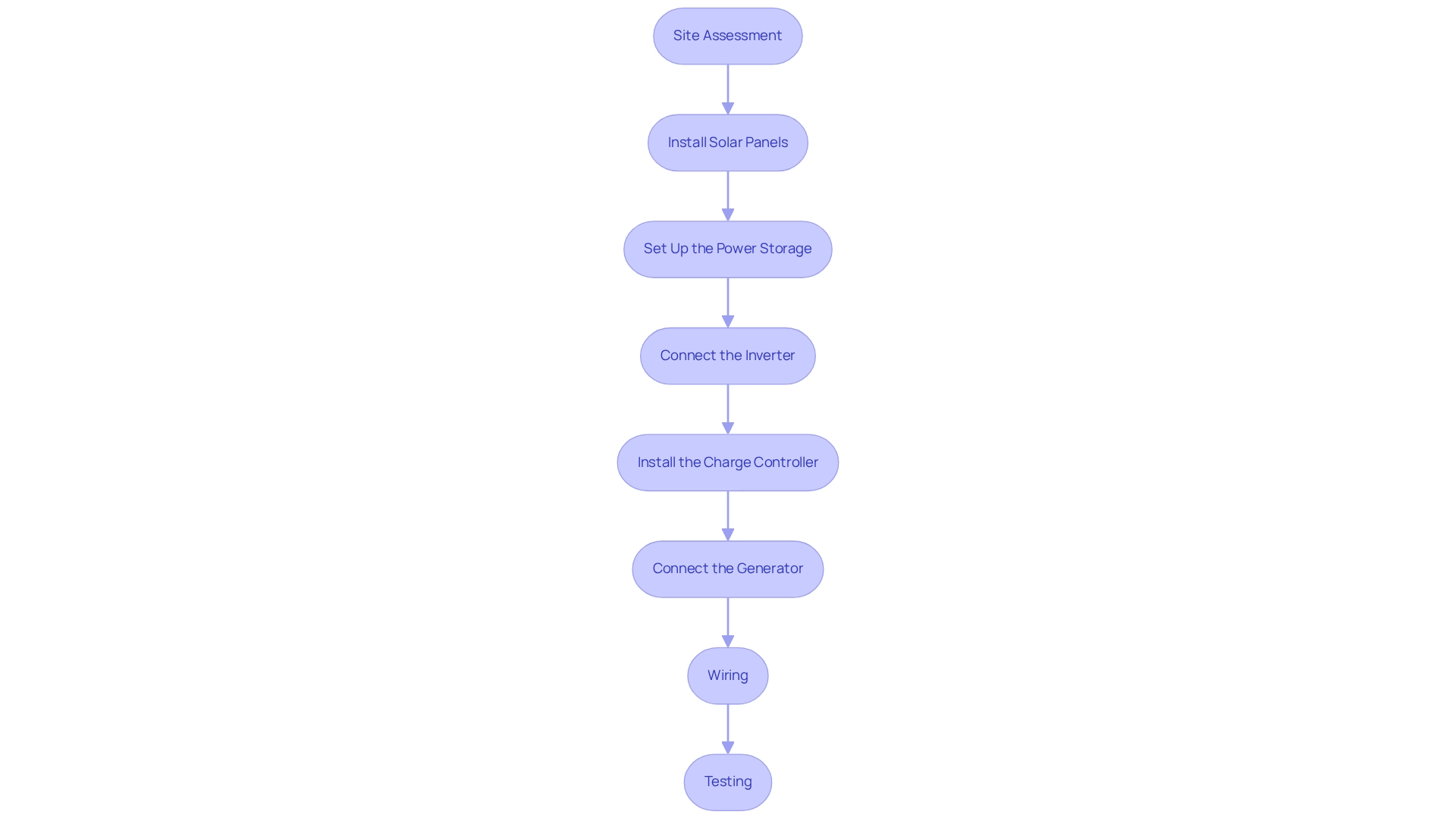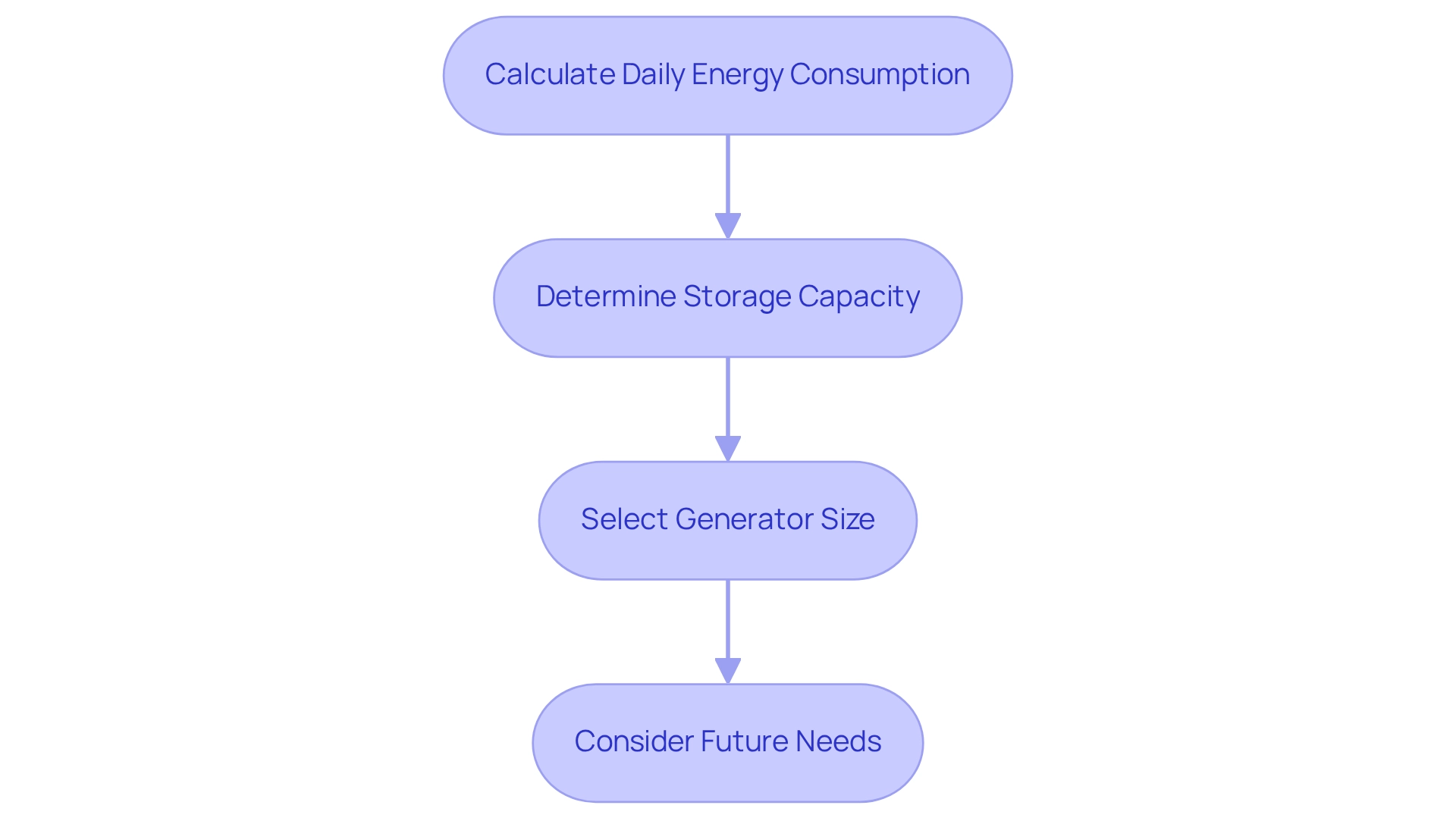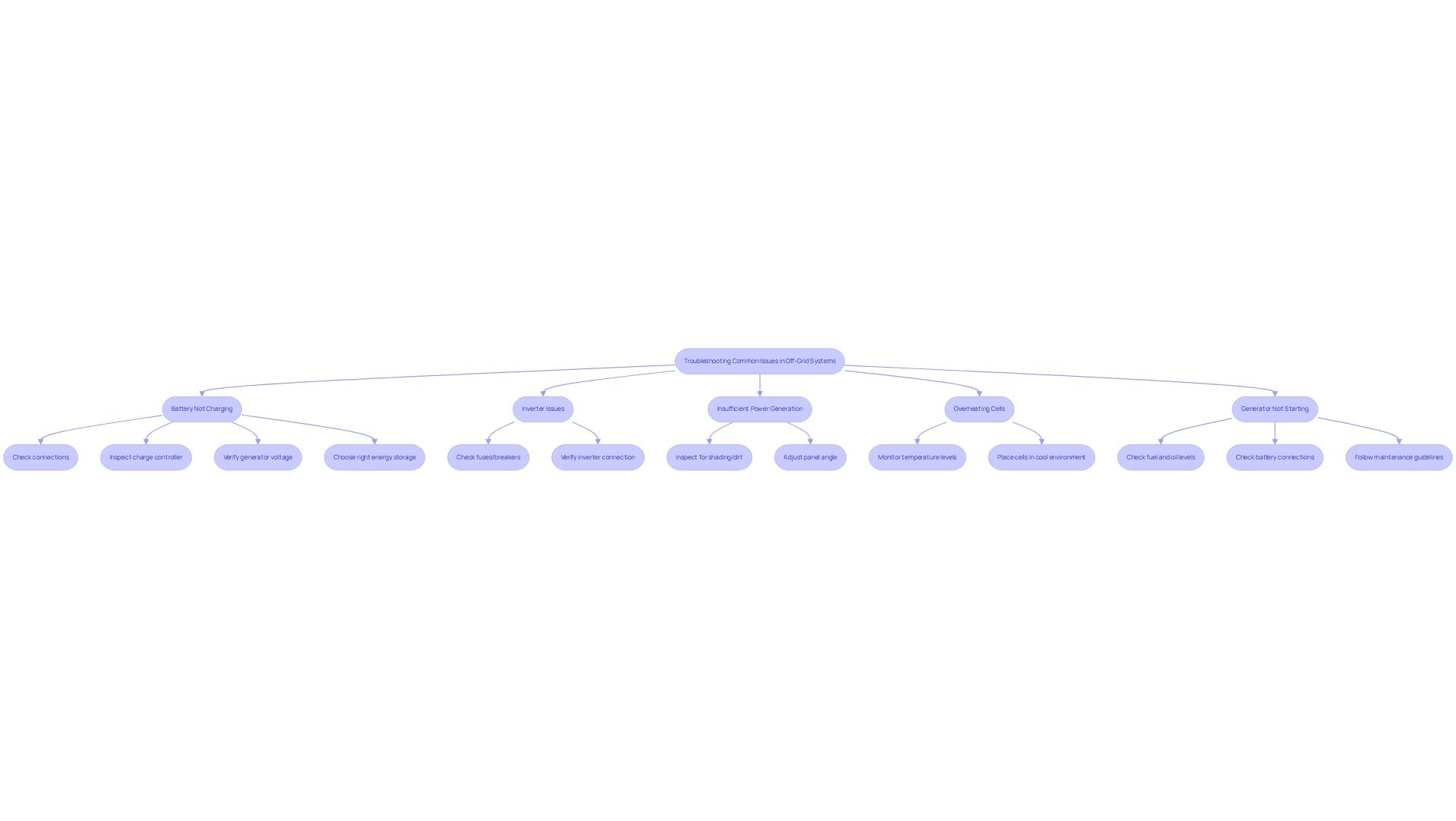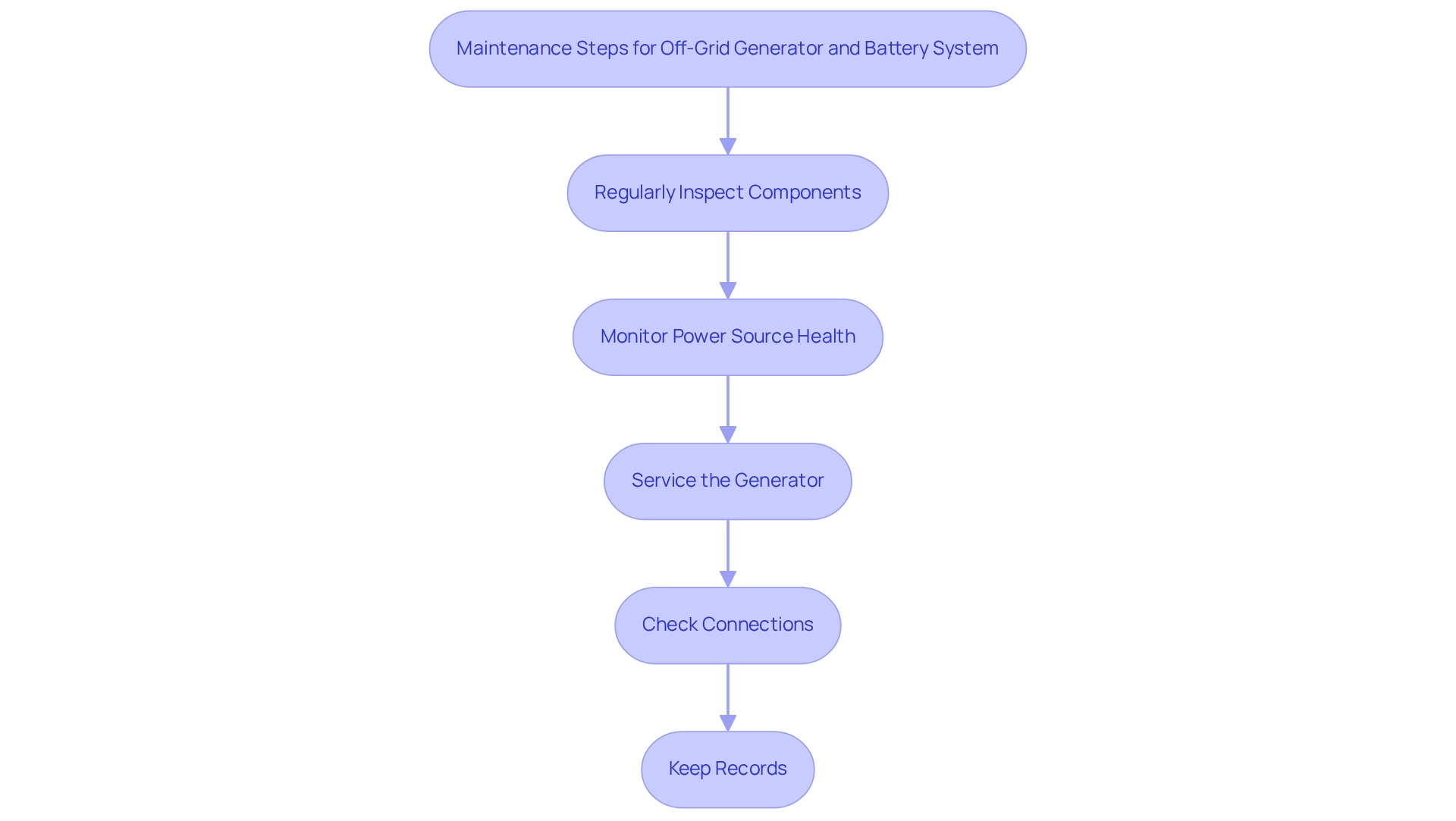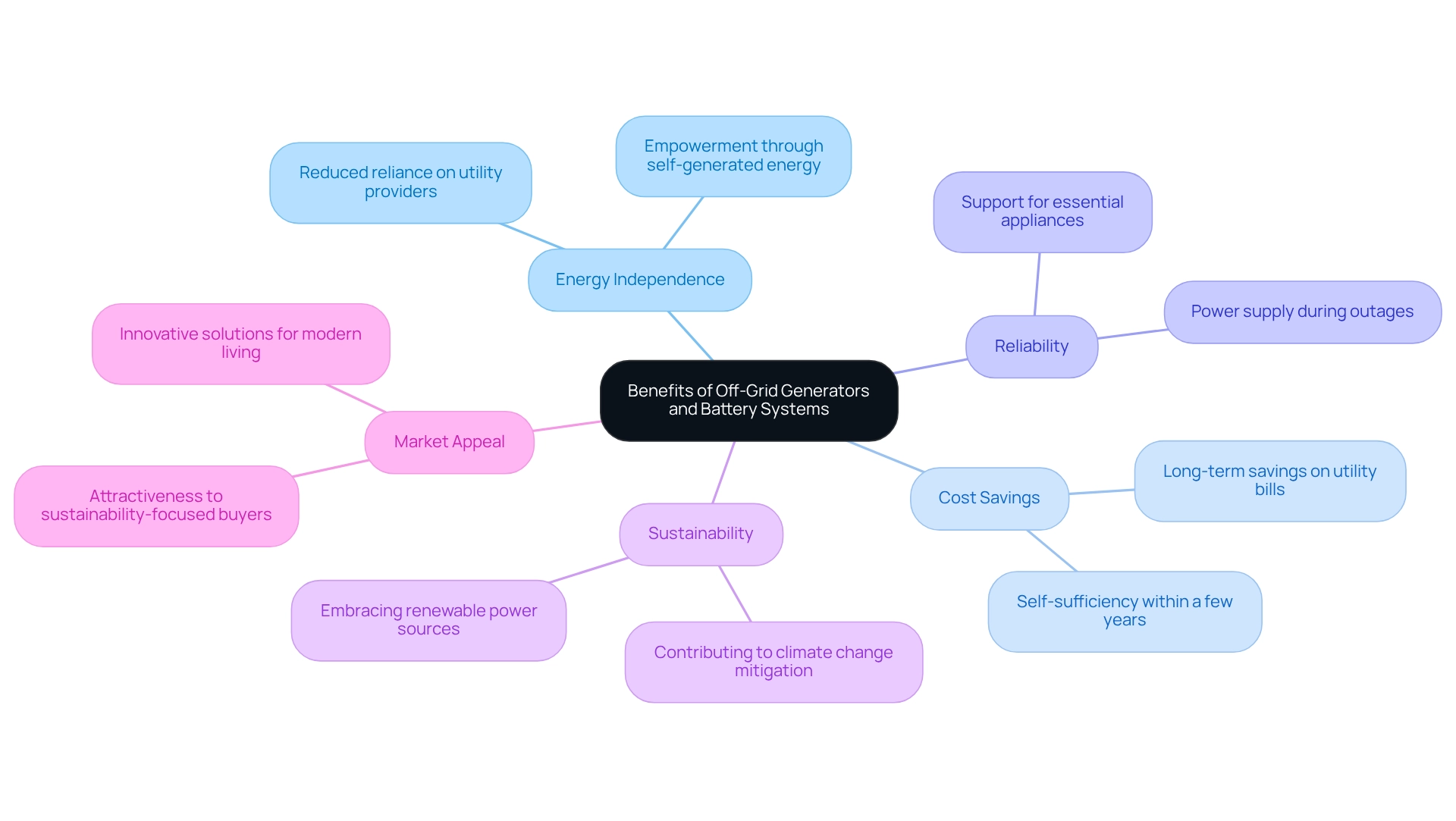Overview
The article titled “How to Set Up Your Off-Grid Generator and Battery System: A Step-by-Step Guide” addresses the concerns many homeowners have about rising energy bills and the desire for more control over their energy needs. It serves as a comprehensive guide for those interested in establishing an off-grid power system, outlining essential components, installation steps, sizing considerations, troubleshooting tips, and maintenance practices. By emphasizing the benefits of energy independence, sustainability, and cost savings, this guide highlights how off-grid systems can empower homeowners to manage their energy sustainably and reduce reliance on conventional utility services.
We understand that navigating the world of off-grid energy can feel overwhelming. However, by detailing the necessary components and offering a structured approach to installation and maintenance, the article reassures readers that they are not alone in this journey. Together, we can explore the meaningful advantages of solar energy and the freedom that comes with energy independence.
This guide not only supports homeowners in understanding the practical steps involved but also nurtures their aspirations for a more sustainable lifestyle. It invites them to reflect on their energy habits and consider the positive impact of making this transition. With the right support and guidance, achieving energy independence is within reach, allowing homeowners to embrace a future filled with possibilities.
Introduction
In a world increasingly focused on sustainability and energy independence, many homeowners are understandably concerned about rising energy bills and the reliability of traditional electrical grids. Off-grid power systems are emerging as a compelling solution, offering autonomy and peace of mind. These innovative systems harness renewable energy sources, such as solar panels, and combine them with efficient battery storage to create a reliable and eco-friendly power supply.
As the desire for self-sufficiency grows, it’s common to feel overwhelmed by the intricacies of off-grid systems. Understanding their essential components and the installation process becomes crucial for those looking to embrace this energy revolution. With advancements in technology and a rising awareness of the benefits of energy independence, off-grid solutions promise not only significant cost savings but also contribute to a greener future.
Together, we can explore the key elements, installation steps, maintenance tips, and undeniable advantages of adopting off-grid generators and battery systems for sustainable living.
Key Benefits of Off-Grid Systems:
- Sustainable Energy: Reduce reliance on fossil fuels.
- Cost Savings: Lower energy bills over time.
- Energy Independence: Freedom from utility price fluctuations.
- Environmental Impact: A smaller carbon footprint.
We understand that making the switch to off-grid living is a significant decision. This article aims to guide you through this process, ensuring you feel supported every step of the way. Let’s work towards a sustainable future together.
Understanding Off-Grid Power Systems
Are you feeling overwhelmed by rising energy bills? Off-grid power setups, such as an off-grid generator and battery system, offer a sustainable and independent energy solution for homeowners like you. By combining renewable power sources, such as photovoltaic panels, with an off-grid generator and battery system for energy storage, you can generate, store, and utilize your own electricity. This ensures a reliable and eco-friendly power supply tailored to your needs.
Understanding the elements and operations of an off-grid generator and battery system is essential for anyone considering this empowering power solution. Key components include:
- Photovoltaic panels that harness sunlight
- Batteries that store surplus energy for future use
- Inverters that convert stored power into usable electricity
This arrangement not only meets your energy requirements but also aligns with broader sustainability goals, such as reducing utility expenses and enhancing your autonomy.
The adoption of off-grid power systems is growing, with recent statistics showing that approximately 15% of California homeowners are utilizing off-grid solar systems in 2025. This trend reflects a growing awareness of the benefits associated with energy independence and cost savings. Moreover, employing an off-grid generator and battery system can significantly reduce reliance on the conventional grid, which is increasingly vulnerable to outages and fluctuating energy prices.
Recent advancements in off-grid technology, particularly in generator and battery systems, have made these solutions even more appealing. Improvements in energy storage capacity and efficiency allow homeowners to effectively utilize their off-grid generator and battery system to store renewable energy for peak demand periods or outages. When selecting a battery, consider factors such as:
- Capacity
- Efficiency
- Lifespan
- Price
- Environmental benefits
Additionally, advocacy efforts by organizations like the Solar Energy Industries Association (SEIA) have led to better regulatory frameworks that enhance the economics of renewable energy and storage investments. For instance, SEIA’s initiatives have focused on establishing fair fixed electric fees for residential clients, improving the economic feasibility of solar + storage solutions, especially when paired with an off-grid generator and battery system.
Real-life success stories demonstrate the effectiveness of off-grid generator and battery systems. Homeowners who have embraced these solutions report significant reductions in their utility expenses and greater resilience against power interruptions. Notably, the Aquamarine solar setup in Lemoore, completed in 2021, boasts a capacity of 325 MW, enough to power over 90,114 homes, showcasing the potential of large-scale solar energy generation in California.
As the renewable energy landscape continues to evolve, the benefits of adopting an off-grid generator and battery system—such as sustainability, reliability, and cost-effectiveness—become increasingly clear. Together, we can work towards a more sustainable future. As Ryan McCarthy, a CCST Science Fellow, poignantly states, “The transition to renewable energy sources is not just a trend; it’s a necessary shift towards a sustainable future.
Essential Components of an Off-Grid Generator and Battery System
To successfully establish an off-grid generator and battery setup, several essential components are required:
- Solar Panels: These are the cornerstone of your system, converting sunlight into electricity. Recent advancements have resulted in the creation of highly efficient photovoltaic panels, particularly advantageous for overcast days. Companies like Powercore Electric, Maxeon, JinkoSolar, Trina Solar, and Longi Green Energy are at the forefront of this technology, providing options that excel even in less-than-ideal weather conditions.
- Battery Bank: This element stores the power produced by the photovoltaic panels, enabling you to use renewable power even when sunlight is not accessible. It’s common to feel concerned about energy bills, and statistics show that roughly 80% of homeowners set up power sources mainly for backup support, highlighting their significance in attaining power autonomy. When choosing a photovoltaic storage unit, take into account essential elements like capacity, efficiency, lifespan, cost, and environmental advantages to guarantee optimal performance. Powercore Electric provides a variety of energy storage solutions designed to accommodate various energy requirements.
- Inverter: The inverter plays a critical role by converting the direct current (DC) electricity stored in the power sources into alternating current (AC) electricity, which is necessary for most household appliances.
- Charge Controller: This device regulates the voltage and current coming from the solar panels, preventing overcharging of the batteries and ensuring their longevity.
- Generator: Acting as a backup power supply, the generator guarantees that your power requirements are fulfilled during prolonged durations of low sunlight or high demand, offering peace of mind.
- Wiring and Connectors: These are essential for securely and effectively linking all elements of your setup, ensuring optimal performance.
Grasping these components is vital for the efficient function of your off-grid generator and battery system, enabling you to fulfill your power requirements sustainably. As emphasized in the SolarReviews Annual Survey 2025, the renewable energy sector is evolving, revealing key trends and challenges that homeowners should consider when establishing their systems. Moreover, with significant firms such as Amazon, Google, and Meta securing over 25 GW of renewable energy capacity, the demand for these components is increasing, emphasizing their value for homeowners seeking to invest in sustainable energy options.
For individuals in Stockton, California, investigating local energy firms, including Powercore Electric, can offer further insights and choices customized to your specific requirements. Together, we can explore how these solutions can meet your energy needs and contribute to a more sustainable future.
Step-by-Step Installation Process for Your Off-Grid System
Are you concerned about rising energy bills and looking for a sustainable solution? Installing an off-grid generator and battery system can be a transformative step towards energy independence. Follow these detailed steps to ensure a successful installation that meets your needs:
- Site Assessment: Begin by selecting an optimal location for your photovoltaic panels. Consider factors such as sunlight exposure throughout the day and accessibility for future maintenance.
- Install Solar Panels: Securely mount the solar panels on your roof or on the ground. Ensure they are angled correctly to capture maximum sunlight, which is crucial for efficiency. For a grid-tied system with an assumption of 20 kWh daily, a system size of 8.27 kWp is suggested as a benchmark for sizing your off-grid generator and battery system.
- Set Up the Power Storage: Position the power storage in a cool, dry area to prolong its lifespan. Connect the power sources according to the manufacturer’s specifications, ensuring proper polarity. Consider options such as lithium-ion cells for their efficiency and longevity, or lead-acid sources for a more economical choice.
- Connect the Inverter: Install the inverter near the power storage unit. Attach it to the power sources, ensuring all links are tight and secure to avoid any energy loss.
- Install the Charge Controller: Position the charge controller between the solar panels and the energy storage system. This device controls the charging procedure, safeguarding the cells from overcharging.
- Connect the Generator: If you intend to utilize a generator, link it to the power storage. This off-grid generator and battery system enables the generator to charge the batteries during periods of low sunlight, ensuring a reliable power supply.
- Wiring: Use appropriate wiring to connect all components. Adhere to safety guidelines to prevent electrical hazards, ensuring that all connections are insulated and secure.
- Testing: After all components are connected, conduct a thorough test of the setup. Verify that each part is functioning correctly before relying on it for your power needs.
By following these steps, you can achieve a successful installation of your off-grid generator and battery system, ensuring that it operates efficiently and reliably for your energy needs. As Todd Bermont, Vice President of Sales and Business Development, states, “Solar power, when done correctly, is one of the most cost-effective, low-maintenance, and reliable solutions for powering remote electronics in today’s connected world.” Remember, upkeep of photovoltaic panels is typically minimal, with cleaning often required only under certain conditions.
Proper care during cleaning and installation is crucial to avoid damage and ensure optimal performance. Powercore Electric’s internal team of specialists guarantees top-notch installations and upkeep, establishing them as a reliable option for your energy and electrical requirements. Together, we can ensure you optimize the financial advantages of your solar power solutions, with services encompassing thorough installation and continuous upkeep customized to your particular power needs.
Sizing Your Off-Grid Generator and Battery System
Sizing your off-grid generator and battery system is crucial for ensuring a reliable power supply. We understand that managing energy bills can be a concern for many homeowners. Here are the essential steps to follow:
- Calculate Daily Energy Consumption: Start by listing all the appliances and devices you plan to use. Record their wattage and estimate daily usage in hours. Multiply the wattage of each device by its daily usage to determine the total daily watt-hours required. This step is vital in understanding your energy needs.
- Determine Storage Capacity: Choose a power bank that can hold enough resources to meet your needs for at least three days without sunlight. This capacity is typically measured in amp-hours (Ah). For example, if your daily usage is 1,500 watt-hours, you would need a storage system with a capacity of at least 4,500 watt-hours (1,500 watt-hours x 3 days) divided by the voltage. Consider alternatives like lithium-ion cells for their efficiency and longevity, as they are among the best solar storage options for residential power.
- Select Generator Size: Choose a generator that can handle the total wattage of all devices that may run simultaneously. It’s essential to include a surge capacity to accommodate appliances with high starting wattage, such as refrigerators and air conditioners. For instance, if your total running wattage is 3,000 watts, consider a generator rated for at least 4,000 watts to handle surges.
- Consider Future Needs: Anticipate any future additions to your power consumption, such as new appliances or devices. By factoring in these possible increases, you can avoid the need for costly upgrades later on.
By following these steps, you can effectively size your off-grid generator and battery system, ensuring it operates efficiently and meets your power requirements. This approach not only fosters independence in power sources but also contributes to reducing California’s carbon footprint, which was recorded at 326.2 million metric tons in recent evaluations. Moreover, with the growing number of electric vehicle charging stations—16,422 as of January 2025—integrating these systems can enhance your sustainable power practices.
Additionally, partnering with Powercore Electric’s dedicated team of specialists ensures high-quality installations and maintenance for your off-grid generator and battery system, providing you with peace of mind that it will function reliably. Powercore Electric offers a wide range of services, including solar panels, battery backups, and EV charging stations, tailored to meet your unique power needs. Real-world examples, such as the California Tribal Energy Grants awarded to Native American tribes for renewable resource development, underscore the significance of effective energy planning and the potential for community-driven solutions in achieving sustainable energy goals. Together, we can work towards a more sustainable future, ensuring that your energy needs are met with compassion and expertise.
Troubleshooting Common Issues in Off-Grid Systems
Common issues encountered in an off-grid generator and battery system can significantly impact their efficiency and reliability. We understand that facing these challenges can be frustrating, especially when you’re striving for energy independence. Here are some prevalent problems and their compassionate solutions:
-
Battery Not Charging: It’s essential to ensure all connections are secure and inspect the charge controller for proper functionality. If a generator is in operation, verify that it is generating the appropriate voltage to recharge the cells effectively. Choosing the right energy storage unit is crucial; examine varieties and specifications that best meet your energy requirements, as outlined in the user manual “Best Energy Storage Options for Efficient Energy Storage.”
-
Inverter Issues: If devices are not receiving power, check for blown fuses or tripped breakers. Additionally, verify that the inverter is correctly connected to the battery bank to ensure a stable power supply. Understanding the best practices for choosing panel inverters, as detailed in ‘How Panels Function on a House,’ can assist in alleviating these issues.
-
Insufficient Power Generation: When photovoltaic panels fail to generate adequate power, inspect them for shading, dirt accumulation, or physical damage. Adjust the panels to ensure they are optimally angled to capture maximum sunlight throughout the day. Regular maintenance and innovative cleaning solutions can enhance solar panel efficiency and longevity.
-
Overheating Cells: Regularly monitor temperature levels, as excessive heat may indicate overcharging or inadequate ventilation. Place power cells in a cool, dry environment to prevent overheating and extend their lifespan. Assessing important factors for choosing solar energy storage can result in greater energy independence.
-
Generator Not Starting: If the generator fails to start, check fuel and oil levels, as well as battery connections. Adhering to the manufacturer’s maintenance guidelines is crucial for ensuring reliable operation.
Along with these typical issues, it’s essential to acknowledge the wider economic framework of the off-grid generator and battery system. For instance, the electricity generated from mini-grids in rural areas remains expensive for clients, highlighting the financial challenges that can arise. A practical instance of regulatory backing for off-grid solutions is observed in Rwanda, where mini-grids with a capacity of less than 50 kW are exempt from licensing requirements, promoting the advancement of small-scale power solutions.
Furthermore, as Michaël Aklin notes, the deployment of off-grid technologies often requires pre-existing well-functioning institutions, which can be a significant barrier in less stable regions. Developing local abilities and enhancing entrepreneurial efforts are crucial for boosting the economic feasibility of mini-grids without subsidies, highlighting the significance of a nurturing atmosphere for off-grid setups.
By understanding these common issues and implementing the suggested solutions, you can enhance the reliability and performance of your off-grid generator and battery system, ensuring a consistent energy supply for your needs. Together, we can navigate these challenges. For more detailed guidance, refer to the user manuals provided by Powercore Electric.
Maintenance Tips for Your Off-Grid Generator and Battery System
To ensure your off-grid generator and battery system operates efficiently, we understand that maintaining it can feel overwhelming. However, with a few simple maintenance tips, you can keep your system running smoothly and confidently.
-
Regularly Inspect Components: Conduct routine checks on photovoltaic panels, batteries, and wiring for any signs of wear or damage. Cleaning the panels is essential to maintain optimal energy capture and performance. Innovative cleaning solutions can enhance efficiency, ensuring that your solar panels operate at their best. For instance, one fan in a charge controller was replaced after just 6 months of operation, highlighting the importance of regular maintenance.
-
Monitor Power Source Health: It’s common to feel uncertain about the longevity of your power sources. Regularly test the voltage and inspect terminals for corrosion. Depending on the kind and utilization, power sources generally require replacement every 5 to 10 years to guarantee dependable performance. Assessing leading solar batteries for power storage, as described in the user manuals, can assist you in making informed decisions that correspond with your power requirements.
-
Service the Generator: Adhering to the manufacturer’s maintenance schedule is crucial. This includes essential tasks like oil changes, filter replacements, and fuel checks. Operating the off-grid generator and battery system regularly is essential to maintain it in good working order, guaranteeing that your off-grid setup remains dependable.
-
Check Connections: Ensuring that all electrical connections are secure and free from corrosion is vital. Loose connections can lead to power loss and diminish the overall efficiency of your setup, affecting your energy independence.
-
Keep Records: Maintaining a detailed log of all maintenance activities, including inspections, repairs, and replacements, is a proactive way to monitor performance. This practice not only assists in detecting potential problems before they worsen but also fosters a sense of control over your energy system. As highlighted in a case study on data types for effective operation and maintenance of solar PV installations, gathering and examining data is crucial for proactive upkeep and prolonging the lifespan of your installation.
By adhering to these maintenance practices, you can greatly prolong the lifespan of your off-grid generator and battery system, ensuring it consistently satisfies your power requirements while encouraging sustainability. As one homeowner from Southern Oregon noted, ‘Overall, it’s been high gain / minimal issues when you compare it to car or home ownership,’ emphasizing the reliability of well-maintained off-grid setups. Powercore Electric is dedicated to delivering outstanding service and assistance, making sure that your shift to sustainable power practices is both effective and community-oriented.
Furthermore, for ideal power storage, explore the top solar storage options emphasized in our user guides. Together, we can improve your setup’s efficiency and enhance your energy independence.
Benefits of Off-Grid Generators and Battery Systems for Sustainable Living
Investing in an off-grid generator and battery system offers numerous advantages that resonate deeply with the values of sustainable living and energy independence.
We understand that many homeowners are concerned about rising energy bills and the unpredictability of utility costs. An off-grid generator and battery system empowers you to generate and store your own energy, significantly reducing your reliance on utility providers. This newfound power autonomy not only shields you from fluctuating costs but also fortifies your resilience against potential power outages.
Moreover, embracing renewable power sources, such as sunlight, is a meaningful step towards sustainability. As Mark Z. Jacobson, a Stanford University Engineering Professor, highlights, “The cost of large-scale solar power projects has dropped substantially in recent decades largely because of economies of scale — just the huge growth of solar on a worldwide scale.” This shift towards sustainable energy practices is crucial for combating climate change and nurturing our planet.
You may also find comfort in knowing that these systems ensure a reliable power supply, even during outages or emergencies. With an off-grid generator and battery system, you can keep essential appliances running, providing peace of mind during unpredictable weather events or grid failures. This reliability is especially important as nearly three-fourths of California households rely on air conditioning, which increases power demands during warmer months.
While the initial investment in an off-grid generator and battery system may seem substantial, the long-term savings on utility bills can be significant. Many property owners discover that their systems become self-sufficient within a few years, particularly as utility expenses continue to rise.
Additionally, homes equipped with these systems, including solar battery units and Tesla home chargers, are becoming increasingly attractive to buyers who prioritize sustainability. This trend reflects a growing interest in self-sufficiency among California homeowners, many of whom are seeking innovative solutions to enhance their living environments.
Real-world examples, such as the Viejas Tribe’s long-duration power storage approach, illustrate the potential of off-grid systems to bolster regional power security while promoting sustainability. In 2022, the California Energy Commission granted $31 million to the Viejas Tribe for this setup, underscoring its role in enhancing regional power security. Experts agree that transitioning to an off-grid generator and battery system not only supports individual homeowners but also contributes to broader environmental goals.
As we consider the transportation sector, which accounts for approximately 85% of petroleum usage in California, the shift to renewable power sources becomes essential for achieving overall autonomy. By understanding these advantages, you can make informed choices about adopting an off-grid generator and battery system that aligns with your values and financial objectives. Together, we can work towards a more sustainable future. Powercore Electric is here to provide innovative solar energy solutions to help you achieve these goals.
Conclusion
Investing in off-grid power systems is not just a choice; it’s a transformative step towards achieving energy independence and embracing sustainability. We understand that rising energy bills can be a source of concern, but by harnessing renewable energy sources like solar panels and integrating efficient battery storage, homeowners can generate and utilize their own electricity. This shift reduces reliance on traditional utility providers, alleviating worries about fluctuating energy prices and significantly lowering carbon footprints, which aligns with our shared environmental goals.
Understanding the essential components, installation processes, and maintenance requirements of off-grid systems is crucial for those considering this transition. With advancements in technology and growing support from regulatory frameworks, these systems are becoming more accessible and economically viable. Homeowners can look forward to substantial long-term cost savings, increased property value, and the peace of mind that comes from a reliable energy supply, even during outages.
The benefits of off-grid generators and battery systems extend beyond individual households; they contribute to regional energy security and promote a collective move towards sustainable living. It’s common to feel apprehensive about such changes, but as more homeowners embrace this energy revolution, the ripple effects on communities and the environment will be profound. The journey towards energy independence is not just a personal choice; together, we can take a crucial step towards a greener future for all. Let’s work towards this brighter tomorrow, hand in hand.


